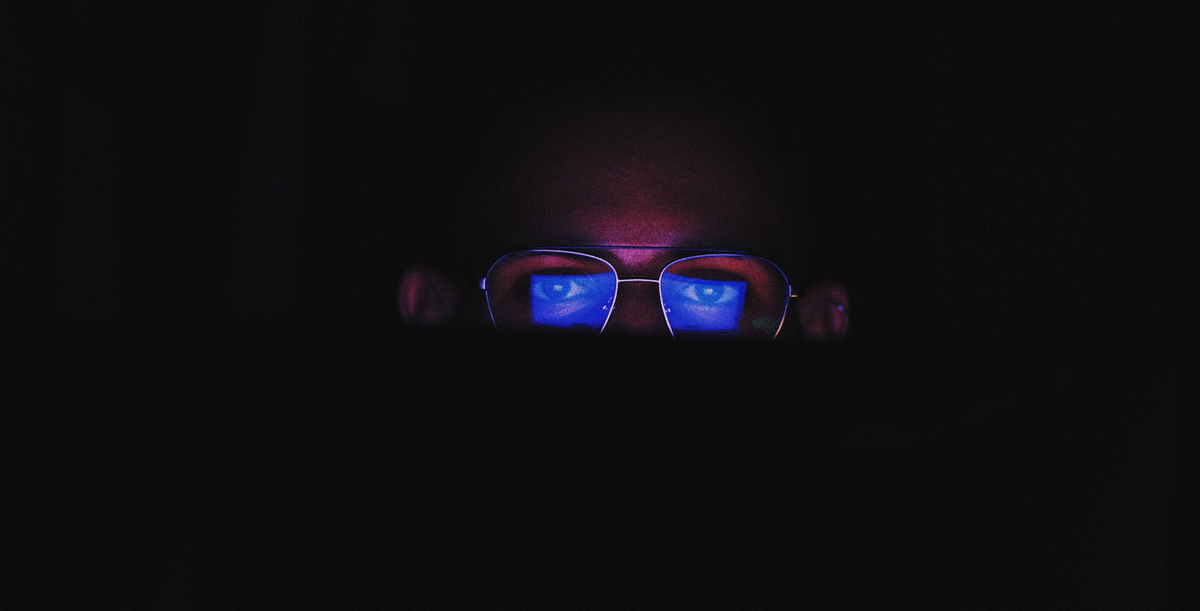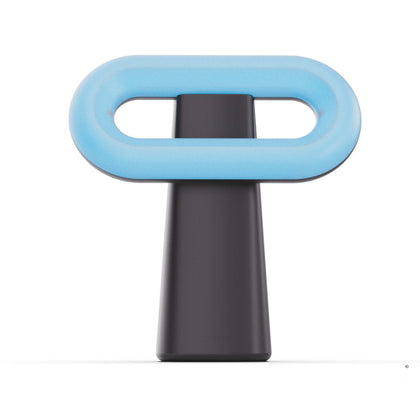
Blue Light Glasses: Hype or a Health Revolution?
|
|
Time to read 7 min
Blue light-blocking glasses seem to be everywhere – from ads on Instagram to established eyewear stores. We surveyed over 500 people in 2020 and found that nearly 15% of people wore blue light glasses.
Vendors claim that blue light from our devices is responsible for digital eye strain, headaches, and even permanent retinal damage. But can blue light really damage your eyes?
Not All Glasses Are Equal
Before going any further, it’s important we make a distinction between the two distinct varieties of blue light glasses: 1) clear lens glasses for daytime computer use; 2) amber-tinted glasses intended for night-time use.
The latter variety has a different purpose: reduce blue light in the evening. Exposure to blue light at night disrupts the circadian rhythm and delays sleep onset. When exposed to blue light at night, the ipRGCs send a false signal to the brain that the sun has not set. The amber lenses prevent this by absorbing blue light7–9. By contrast, 'blue light' glasses with clear lenses let in the light that entrains your circadian rhythm, but block short-wavelength blue light (400-455nm), which vendors claim can damage your eye.

There's only one problem. There's no conclusive evidence linking screen-use with retinal damage. The Royal Australian and New Zealand College of Ophthalmologists (RANZCO) issued the following statement on Blue Light Blockers in July 2019.
"No evidence exists to suggest that normal environmental exposure to blue light, including those from digital screen technology, causes damage to eyesight. Filtering out the blue light from screens is not necessary in general use1."
Although the LEDs that light our homes and devices emit more blue light than most artificial lighting technologies of the past, they still emit hundreds of times less blue light than sunlight. If blue light were the cause of eye strain, one would expect those spending time outdoors to be worse affected.
Fears that screens damage our eyes have been around for almost as long as the screens themselves. I remember my mum warning me that I'd get square eyes if I watched too much TV. Blue blocking glasses aren't new either. They first emerged in the 1980s when NASA realised astronauts needed extra protection from the stronger radiation in space2. But in recent years,' blue light' glasses have exploded in popularity as brands have tapped into the growing sense that we spend too much time on our devices.
Many ophthalmologists believe that people experience discomfort when staring at screens for extended periods because they blink less. Our eyes become dry, as a result, causing pain and even blurry vision. Staring at a screen can also tire the muscles in your eyes, as we haven't evolved to focus on a fixed plain for hours at a time. To mitigate eye strain, ophthalmologists suggest the 20-20-20 rule: every twenty minutes, take a twenty-second break by blinking and looking at something twenty feet (6 metres) away.
But these explanations are unconvincing for the thousands of people who claim 'blue light' have helped them. Have these people had the wool pulled over their eyes? Is it simply an example of post-purchase rationalisation occurring on mass? Or is there something else going on behind our screens?
Daniel Georgiev, the founder of the popular blue light filter app Iris, thinks so. As a young boy, his vision was perfect. But when he became a programmer, often spending 10 hours a day at the computer, he started suffering eye strain3. Shortly after, he got glasses for the first time in his life. According to Georgiev, the main culprit for digital eye strain is the flicker of screens.
The backlight in your screen flashes on and off hundreds of times per second to reduce energy consumption. This is called flicker. Although these pulses happen so fast that our brain can't perceive them, they're slow enough for eyes pupils to expand and contract—which may result in eye strain3,4. Some people also report non-perceivable flicker triggers migraines and anxiety attacks, although it seems individual sensitivity to flicker varies greatly.
Perversely, as people dim their screens to reduce eye discomfort, they may do more harm than good. As you reduce the screen brightness on most consumer displays, the intervals between each backlight pulse increase, heightening the risk of eye strain. That may explain why fewer people experience eye strain from books (and e-readers). And it helps explain why blue light glasses could help—by reducing the intensity of each backlight pulse. Georgiev proposes another solution, however: locking your brightness at maximum and dimming it using special software3 (such as his app, Iris.)
"Exposure to blue light at night disrupts the circadian rhythm and delays sleep onset. When exposed to blue light at night, the ipRGCs send a false signal to the brain that the sun has not set."
More to the Eye Than Meets the Eye
LEDs have only seen widespread adoption in the past decade. For that reason, some fear that LED-backlit displays haven't been around long enough to know their full effects. But to understand why they believe the spectrum of LEDs poses a risk to eye health, we're going to have to cover a little bit of biology.
Our eyes contain two image forming cells:
1) Rods, super-sensitive cells that allow us to see in dim conditions;
2) cones, of which we have three varieties (short, medium and long) that allow us to see in colour during the day.
But scientists discovered a third photoreceptor about twenty years ago, called photosensitive retinal ganglion cells (ipRGCs). Like the rods and cones, ipRGCs detect light. But unlike the other photoreceptors, ipRGCs do not contribute to vision. Instead, they signal to the body's master clock to keep the circadian rhythm in sync with the day. These cells also control the pupil to dictate how much light the eye allows in.
The visible spectrum ranges from red, long wavelengths at one end and blue and violet light at the shorter end. Technically, 'blue light' is wavelengths between 400-500nm. ipRGCs are sensitive to a narrow band of the visible spectrum, peaking at 480nm. Sunlight contains a broad spectrum of wavelengths, including the short-wavelength blue light that is potentially harmful to the eye. But this hazardous blue is paired with plenty of light at 480nm, allowing the ipRGCs to respond accordingly and shrink the pupil to restrict the amount of light allowed into the eye, naturally protecting the retina.

The LED's lighting our devices contain hazardous blue (peaking at 455nm), but very little light at 480nm, which may circumvent the eye's natural protection mechanisms. Dr Stephen Mason, a Fellow of the American Academy of Optometry5, warns that long-term exposure to light of this sort may damage the eye6. And there is some preliminary research to support his view. A paper published in 2016 concluded; "the blue component of the white-LED may cause retinal toxicity at occupational domestic illuminance and not only in extreme experimental conditions, as previously reported." This is far from conclusive—more research into the long term effects needs to be done.

What we know for certain
In an era where information is just a search away, we've come accustomed to having all the answers. But—as I was reminded writing this blog—there are still things that we don't yet know. We still don't know whether exposure to blue light, the unique spectrum of LEDs or flicker is the root of digital eye strain —or possibly a combination of all three. More research needs to be done before we know whether there is a link between screens and macular degeneration.
But there is one thing that everyone seems to agree on: we could benefit from more light at 480nm during the day, certainly for our circadian rhythm and possibly our eye health too.
Sufficient light at 480nm is vital for keeping our circadian rhythm on a regular cycle. It also helps the eye manage how much light enters the eye, potentially mitigating the risk of macular degeneration. The increase in light also minimises the effect of flicker by equalising the difference in brightness between pulses. And ophthalmologists now believe that children need more of this light to prevent short-sightedness—a condition that has been on the rise globally11.
For most people, increasing daytime exposure to light at 480nm means spending significantly more time outdoors or positioning their workspace next to a window. If you're among the 40% of office workers in New Zealand and Australia who lack access to natural light, consider investing in a circadian desk lamp like Loop. Loop is engineered to support your circadian rhythm by adding the optimum amount of 480nm during the day and zero blue at night.

Conclusion
If you're looking for a solution backed by a large body of evidence, then 'blue glasses' for daytime use probably aren't for you. If you're someone who prefers to air on the side of caution, then they may be worth trying (some vendors offer free returns). Some vendors offer a trial period, giving you the chance to see if they help. On the other hand, 'blue light' glasses for evening use effectively reduce blue light exposure at night.
References
- Blue Light and Digital Screens. (2019).
- BluBlocker Sunglasses: A major vision breakthrough. BluBlocker https://www.blublocker.com/.
- How technology is killing our eyes | Daniel Georgiev | TEDxVarna - YouTube. https://www.youtube.com/watch?v=HN30fO2I2aU.
- How Мonitors Destroyed our Eyes? | IrisTech. 💡👨💻 Iris - Software for Eye protection, Health and Productivity 🛌👀 https://iristech.co/pwm-flicker/ (2015).
- Sustainable Eye Health Pty Ltd. http://sustainableeyehealthptyltd.com.au/.
- LightSafe - A Vision for Safer Illumination. http://lightsafe.com.au/.
- Ayaki, M. et al. Protective effect of blue-light shield eyewear for adults against light pollution from self-luminous devices used at night. Chronobiol. Int. 7.
- Shechter, A. Blocking nocturnal blue light for insomnia_ A randomized controlled trial. J. Psychiatr. Res. 7 (2018).
- Blue Blocker Glasses as a Countermeasure for Alerting Effects of Evening Light-Emitting Diode Screen Exposure in Male Teenagers. J. Adolesc. Health 7 (2015).
- Roenneberg, T. & Merrow, M. The Circadian Clock and Human Health. Curr. Biol. 26, R432–R443 (2016).
- Kids are spending less time outdoors — and it's causing short-sightedness. https://www.abc.net.au/news/2017-03-02/short-sightedness-epidemic-as-people-spend-less-time-outside/8318882 (2017).



